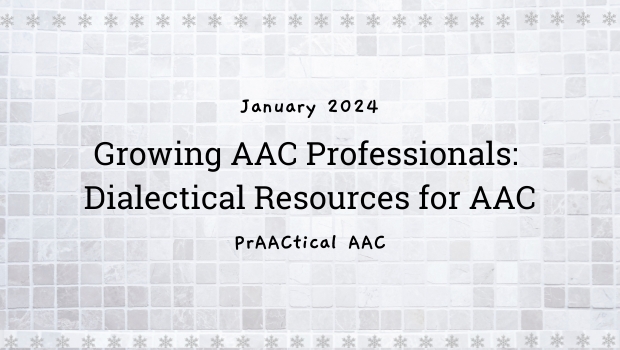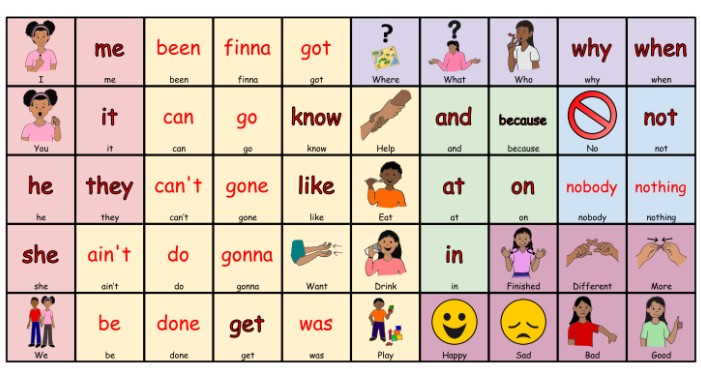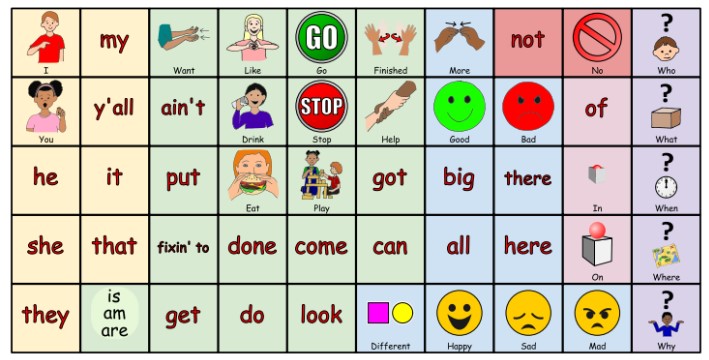Growing AAC Professionals: Dialectical Resources for AAC

While the field of AAC has made considerable progress in boosting the accessibility of SGDs and AAC apps in multiple languages, not as much work has been done in the area of dialectical differences. Today’s guest post by Vicki Haddix discusses how she and her graduate students are addressing this issue. Don’t miss the resources they share.
Vicki is an AAC SLP and a Clinical Assistant Professor at the University of Memphis. You can read other posts by Vicki here.
::::::::::::::::::::::::::::::::::::::::::::::::::::::::::::::::::::::::::::::::::::::::::::::::::::::::::
When I designed the AAC course, I tried to incorporate elements of Universal Design for Learning (UDL) within the class. One of the elements I’m particularly proud of is allowing the students to choose their own final projects, which are worth 50% of their grade. I give them the following guidelines:
Your final project should:
- Collect information from a variety of sources (i.e., not only a survey or only research articles);
- Ground itself within the field of AAC specifically and SLP generally (this may or may not take the form of a literature review);
- Explicitly state how the information in the project is important to SLPs and/or users of AAC and their families and;
- Be well organized.
I meet with each student, individually or in pairs who chose to work together, to decide on the project. The students check in with me as needed through the rest of the semester, and then present to each other about what they did on the final day of class.
While there is nothing in the guidelines I give them that says their project should be practical and ready to distribute to the AAC community, more and more projects over the years have gone in this direction. Which is great, and I think they deserve a wider audience. I hope PrAACtical AAC readers will agree with me and find these materials useful.
During the spring semester’s class, Frewine Ogbaselase and Kathy Ha came to me initially thinking about AAC abandonment, and reasons why families may not have buy-in to AAC. As we talked, one of the reasons that came up was the lack of AAC options for families who use dialects and those who code-switch between dialects and mainstream English. There’s some research on this topic, and Frewine and Kathy put together an overview as part of their presentation. They also designed an AAE (African American English) dialect core board in LessonPix, with some fringe words that are specific to the Memphis AAE dialect.
And then during the summer semester’s class, Erika Taylor expanded on Frewine and Kathy’s work. She was inspired by her mother, who is a teacher in middle Tennessee. Many of her mother’s students use the Southern Appalachian dialect, and Erika wanted them to have some communication boards that reflect their dialect as well (see her presentation here). She also used LessonPix to create a core board and some fringe words that are specific to the area in middle Tennessee where she grew up, and her mother continues to work.
I hope these communication boards can continue and support the discussion on including dialectal variations in AAC systems. I also hope they spur AAC device developers into thinking more about how we can easily facilitate settings in devices that make these choices more widely available to AAC users.
You can find the communication boards in the sharing center on LessonPix and Frewine, Kathy, and Erika’s presentations here.
Filed under: PrAACtical Thinking
This post was written by Carole Zangari
